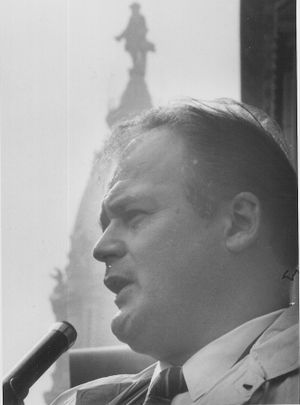Charles Coates Walker facts for kids
Quick facts for kids
Charles Coates Walker
|
|
|---|---|

Speaking at peace rally, Philadelphia 1965
|
|
| Born | September 17, 1920 |
| Died | July 11, 2004 (aged 83) |
| Occupation | American Quaker activist |
Charles Coates Walker (September 17, 1920 – July 11, 2004) was an American Quaker activist. He was a trainer for nonviolent direct action. This means he taught people how to protest peacefully to make changes. He worked for both civil rights and peace.
Throughout his life, Charles Walker worked to make people aware of big problems. These included segregation (keeping people apart based on race), racial injustice, and war. He also spoke out against nuclear and biological weapons. He used methods based on the ideas of Mahatma Gandhi, which focused on nonviolence. He wrote training guides and helped organize marches, peaceful protests, meetings, and campaigns around the world.
Early Life and Education
Charles Walker was born on a farm in Gap, Pennsylvania. His parents were Joseph and Mina Coates Walker. He finished college at Elizabethtown College in Pennsylvania in 1941. He earned a Bachelor of Arts degree. In 1942, he married Marian Groff, who was also a student at Elizabethtown.
During World War II, Charles Walker was a conscientious objector. This means he believed that war was wrong and refused to join the military. Because of his beliefs, he was jailed for not cooperating with the draft.
Working for Civil Rights
From 1946 to 1948, Walker worked for the Ohio branch of the American Friends (Quakers) Service Committee (AFSC). He traveled to college campuses as a regional secretary. His job was to share ideas about peace and fairness for all races.
From 1948 to 1960, Walker worked in Philadelphia for the Fellowship of Reconciliation (FOR). He was the Middle Atlantic Regional Secretary. He visited Crozer Theological Seminary for the FOR. There, he found that many students were interested in nonviolence. In 1949, he arranged for his boss, A. J. Muste, to speak at Crozer. Dr. Martin Luther King Jr. studied at Crozer from 1948 to 1951. King later wrote that he first learned about peaceful protest from Muste's lecture.
Working with the Philadelphia Yearly Meeting Friends (Quakers) Peace Committee, Walker helped create a pamphlet in 1957. It was called A Perspective on Nonviolence. This guide was used by civil rights groups and trainers. In 1961, he published his own book, Organizing for Nonviolent Direct Action.
Throughout the 1960s, Charles Walker helped find and train people for peaceful actions. These actions aimed to fight racial injustice. They included:
- Freedom Rides
- Sit-ins
- The 1964 Mississippi Freedom Summer Project
- The 1963 March on Washington
During the Montgomery Bus Boycott, he met and wrote letters to Dr. Martin Luther King Jr.
Working for Peace
Throughout his life, Charles Walker studied and wrote about nonviolence. He spoke about how powerful peaceful methods could be. His ideas were based on Gandhi's life and writings.
He took action to protest the use of Culebra Island in Puerto Rico. The US Navy was using it for artillery training. His efforts helped stop the Navy from using the island for training during the Vietnam War. He also helped organize the Vigil at Fort Detrick. This was a protest that lasted almost two years. It spoke out against germ warfare research.
Walker was a founding member of the World Peace Brigades (WPB). He also helped start and served on the board of Peace Brigades International (PBI). In 1991, he received the Jamnalal Bajaj International Award. This award recognized his work in spreading Mahatma Gandhi's ideas outside of India.
Charles Walker edited a book called Quakers and the Draft (1968). He also wrote A World Peace Guard: Unarmed Agency for Peacekeeping (1981). He wrote many other pamphlets and articles too.

